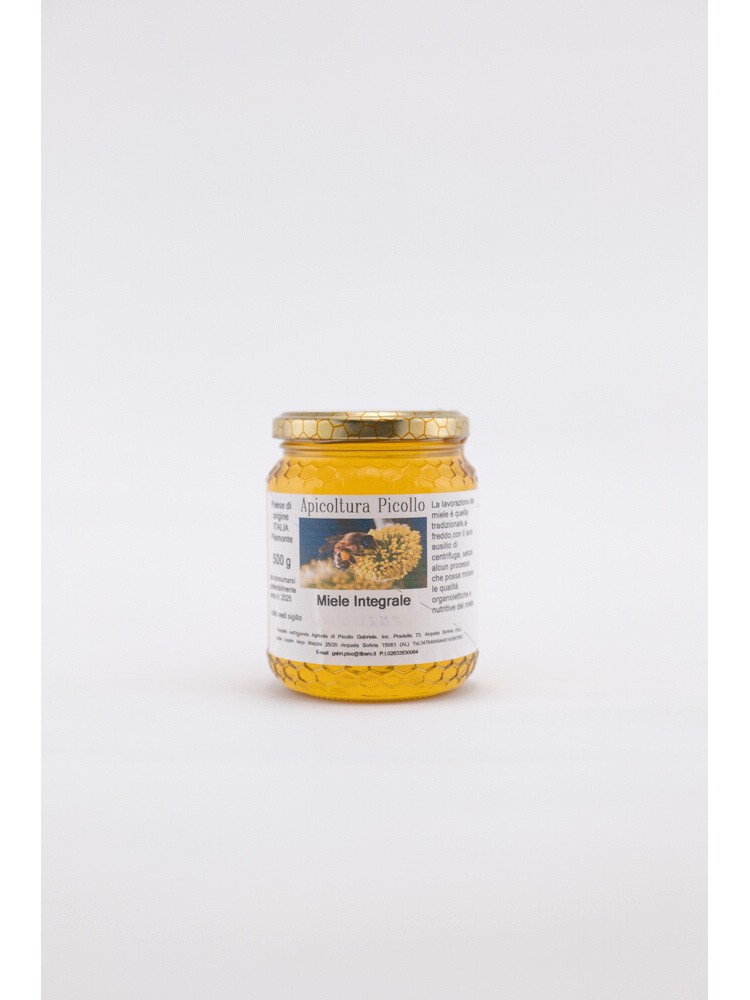


- Acacia honey is a monofloral honey, meaning that unlike the more common multifloral honey, it is made only from the nectar of acacia flowers.
Hives are placed in areas with abundant robinia (or acacia) plants; in contrast, for multifloral honey, hives are located in regions where no single species prevails. This type of honey is among the most appreciated and widespread in Italy, thanks to its strong sweetening power and very fluid consistency. It has a particularly delicate taste that doesn’t alter the flavor of foods and drinks it’s added to.
It’s rich in minerals, especially potassium, calcium, sodium, and phosphorus, as well as vitamins, particularly B group. It contains no fat and has a good level of amino acids, especially aspartic acid and glutamic acid.
Cherry blossom honey offers great benefits for our body.
It is an excellent detoxifier, and thanks to its diuretic properties, it helps the kidneys eliminate waste. Another important characteristic, shared by all honey varieties, is its role as an immediate source of energy, supporting the body’s nutritional needs. Additionally, it’s rich in vitamins and minerals and is a great restorative. It acts as an antioxidant, protecting the body from the harmful effects of free radicals and premature aging. It has antibacterial properties and helps combat respiratory infections: it reduces sore throat, relieves cough, stimulates appetite, and strengthens the immune system. Cherry blossom honey can also be used as a cosmetic, especially as a beauty mask for dull skin, restoring its brightness and radiance.
- Wildflower honey is useful for treating flu symptoms, helping to soothe coughs, and providing antibacterial effects. It’s a valuable source of energy, ideal for athletes, children, pregnant women, recovering patients, and the elderly. According to some studies, wildflower honey can help fight seasonal allergies. When consumed in small doses, people have noticed an improvement in their body's reactions. This honey also benefits the intestines and digestive system. It can relieve constipation, balance bacterial levels, and improve nutrient absorption efficiency. Moreover, it’s valued for liver detoxification and improving circulation.
- Lupinella honey is a rarity and a true symbol of biodiversity. Many beekeepers place their bees and hives in areas where the lupinella plant grows. Lupinella (Onobrychis viciifolia) is a perennial herbaceous plant with pink petals. Commonly found in meadows and mountain pastures, it blooms from May to August. Its standout feature is the flowers, grouped in long conical clusters, in an intense pink color. They’re mesmerizing to look at—just as they attract bees with their nectar and pollen, producing the delicate Lupinella honey, part of the rare and prized honey varieties. Like other honeys, Lupinella honey has key properties. Regular intake can help relieve liver disorders and detoxify it. Additionally, it has sedative, soothing, and antiseptic properties.
- Castiglio honey – chestnut & linden has powerful liver detoxifying properties. It also promotes circulation, soothes sore throats, disinfects the urinary tract, combats anxiety and insomnia, and fights free radicals. It’s one of the most widely used honeys in cooking, especially paired with aged cheeses like pecorino and goat cheese. It’s appreciated on savory meat dishes but is not recommended as a sugar substitute for sweetening teas or infusions due to its bitter taste.
| NUTRITIONAL INFORMATION – AVERAGE VALUES PER | 100 g |
| Energy | 304 kcal |
| Fat of which saturated |
0 g |
| Carbohydrates of which sugars |
82.4 g 82.12 g |
| Protein | 0.3 g |
| Salt | 4 mg |
Produced by the agricultural company of Pastrano Rosalba, located in Arquata Scrivia (AL).